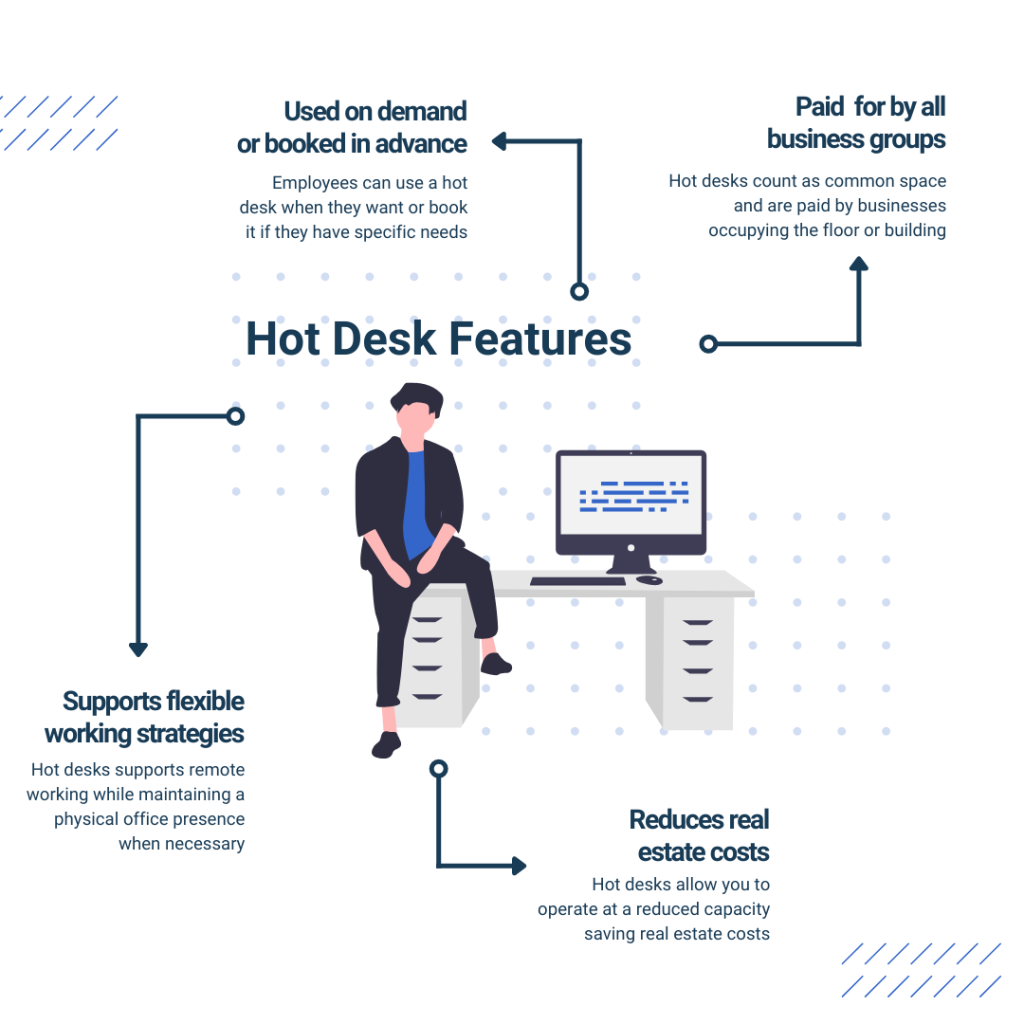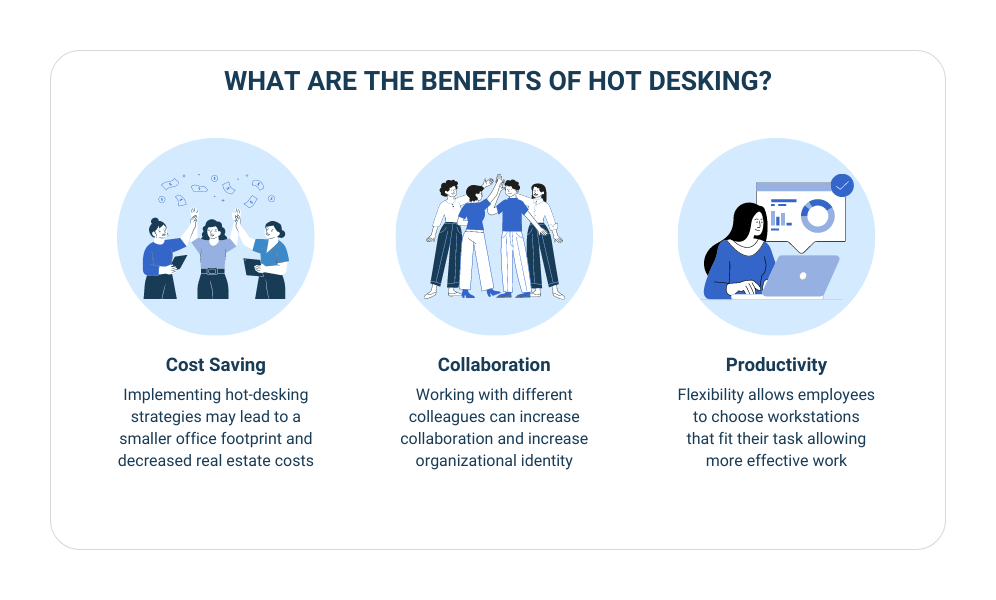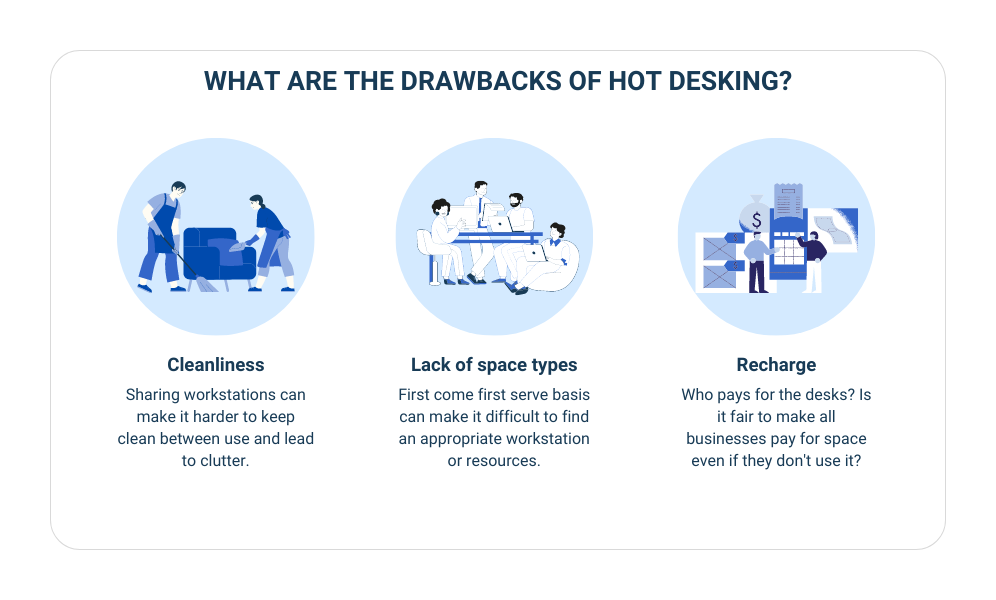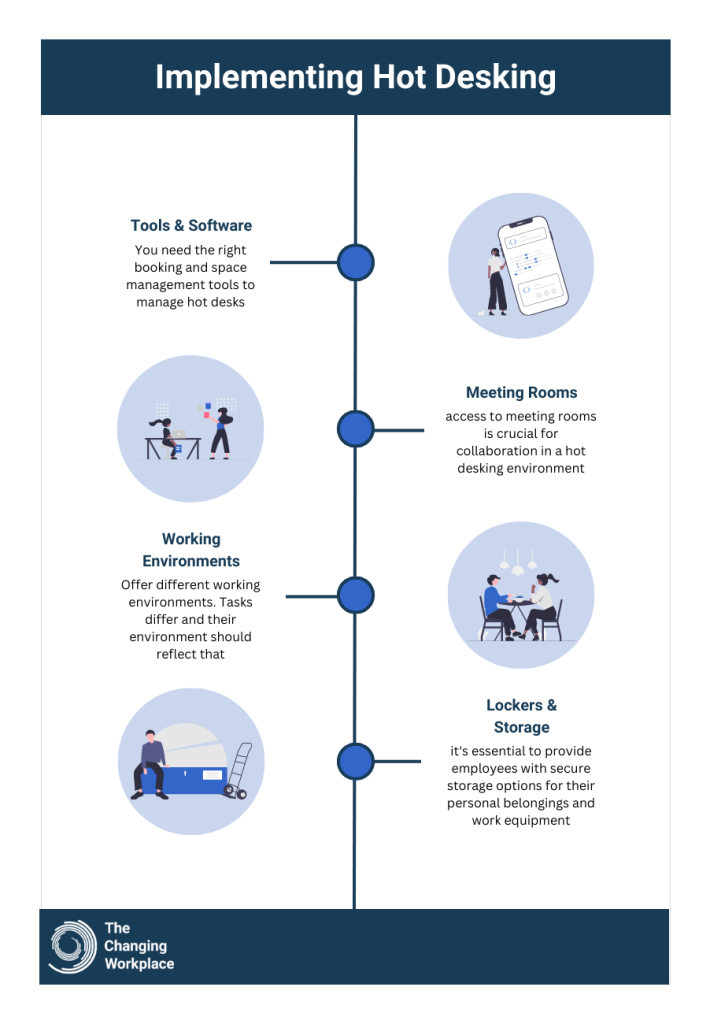What is a hot desk?
A hot desk is a type of workspace with no fixed desks and can be used on demand by anyone at any time or booked in advance using reservation software. Hot desks typically are classed as common space in an organisation’s space standards and on floor plans, meaning they are paid for by the departments that occupy the floor plan (or building depending on how the space is prorated).
Additionally, in workplace management software, hot desks typically contribute to building capacity, but, as they are not fixed desks, do not contribute to occupancy count.
What is hot desking?
Hot desking means employees share office desks on a flexible, first-come, first-served basis, rather than everyone having the same permanent desk every day. This makes hot desking a popular solution for modern offices, particularly in the era of hybrid working, as it supports remote working while maintaining a physical office presence when necessary.
The traditional office, with permanent desks for all employees, does not work anymore. Organizations are experiencing huge quantities of wasted space, which costs a lot of money! Instead, hot desking works to promote efficient use of office space by transforming permanent desks and private offices into a flexible workspace that operates on reduced capacities.
In a hot desking environment, employees are encouraged to use any unoccupied workstation they find suitable, and their belongings are typically stored in personal lockers. The primary objective is to optimize space utilization and reduce real estate costs.

Benefits of Hot Desking Model
Cost Savings
One of the main benefits of hot desking is the potential for money saving. By reducing the number of assigned desks, companies can optimize the use of their office space and minimize expenses related to utilities and rent. Implementing hot-desking strategies may lead to a smaller office footprint and decreased real estate costs, benefiting the business financially.
Collaboration and Teamwork
Hot desking can encourage more collaboration and improve teamwork. As team members share workspaces with colleagues from different departments, they have the chance to get to know each other and exchange ideas. This setup fosters employee engagement and a greater sense of community and organizational identity.
Efficiency and Productivity
By allowing employees to choose their work environment based on their daily tasks, hot desking can contribute to increased efficiency and productivity. This flexibility can help team members to adapt their workspaces to specific projects, making better use of the available resources and enabling them to work more effectively.
In conclusion, hot desking offers cost savings, improved collaboration and teamwork, and increased efficiency and productivity in the workplace.

Drawbacks of Hot Desking
Cleanliness and Clutter
One challenge of hot desking is maintaining cleanliness and controlling clutter. Since employees share desks, it’s essential that everyone keeps the workspace clean and organized. A cluttered or messy desk can be distracting, and the transferring of germs or bacteria can be a concern, especially during a pandemic. Ensuring employees clean their workstations after use and providing adequate cleaning supplies can help mitigate these issues.
Lack of Space Types
Hot desking operates on an ad hoc basis, which means that employees choose their desk as they come into the office. This can sometimes lead to difficulties in finding an appropriate workstation or resources for their tasks. It can also create challenges when collaborating with different teams, as there might be a lack of dedicated spaces for project-related discussions.
To address these challenges, companies can implement flexible solutions such as offering various workspaces like meeting rooms, quiet rooms, and communal areas to cater to different workstyles and adapting to the temporary nature of hot desking. Additionally, implementing booking systems and office hoteling can help employees better plan their workspace needs and ensure seamless team collaboration.
Who Pays For The Desks?
One challenge businesses face from hot desking is who pays for the desks when you have a mix of bookings and ad-hoc seating. Is it fair to make all businesses pay for space? what if hot desks are only used by a few business groups? You can see how this creates a headache for facilities teams!

Where Is Hot Desking Used?
Flexible and Activity-Based Working
Hot desking is a workplace organization strategy where employees don’t have a set workspace. Instead, they can work in different locations throughout the office space, using available desks and resources as needed. This provides flexibility for employees, particularly those who work remotely or have varied schedules. It allows team members to choose their preferred workspace depending on the work they are doing.
Remote workers can greatly benefit from hot desking, as they may not need a dedicated desk at the office. When they visit the workplace, a hot desk provides them with a temporary, comfortable spot to work. Hot desking is a great option for organizations that have a lot of contractors. Rather than onboarding contractors to your room booking system, contractors can use your empty desks as hot desks!
Hybrid Work Model
The hybrid work model combines working from home and working in the office, allowing employees to choose how they work best. Hot desking supports this model by offering unassigned seating options for team members when they’re in the office. Instead of maintaining your own space with dedicated personal desks that may go unused, hot desking allows you to operate at a reduced capacity whilst still serving those that need space.
The hybrid work model aims to balance the benefits of remote work with the advantages of in-person collaboration. By leveraging hot desking, organizations can adapt to the evolving needs of their workforce and create a more efficient office environment.
Coworking Spaces
Hot desking is often implemented in coworking spaces, which provide shared office environments for freelance professionals, entrepreneurs, and small companies. These spaces typically offer a variety of resources and facilities, including hot desks, private offices, and meeting rooms.
In these spaces, participants share resources, collaborate, and network with other professionals. Hot desking helps coworking spaces maintain maximum space efficiency, as desks can be used by different people at different times without redundancies. This in coworking space alleviates real estate risk and promotes a flexible work environment that nurtures innovation and growth.
Hot Desking Setup
First-Come, First-Served Basis
Hot desking is an organizational workspace system that operates on a first-come, first-served basis. Employees come into the office and choose an available workspace for the day without the need for booking specific desk ahead of time. This setup helps to maximize space efficiency and reduces the need for dedicated personal desks.
Hot Desks and Workstations
When setting up a hot desking environment, the office is usually equipped with multiple hot desks and workstations that can be easily accessed by employees. These stations are unassigned and contain the necessary equipment and resources for employees to carry out their work effectively.
Shared Workspaces
Shared workspaces play a crucial role in the hot desking setup. These spaces provide employees with areas where they can work collaboratively or individually on different projects. Some examples of shared workspaces include:
Breakout areas for informal discussions
Meeting rooms for team collaboration
Quiet zones for employees who need a focused environment
These shared areas not only enhance the efficiency of the hot desking system but also contribute to building and maintaining a dynamic and innovative office culture. By offering a variety of workspaces, employees can select the most suitable environment that aligns with their work style and preferences.
Implementing Hot Desking
Tools and Software
To successfully implement hot desking in your own office, it’s important you have the right tools. For the greatest chance of success, you need:
Access Control Systems
Desk Sensors
Room booking software
Room booking software allows employees to book space ahead of time. This gives peace of mind that they are guaranteed a workspace when they go to the office. Furthermore, desk booking software gives organizations usage data to measure performance.
As hot desks don’t necessarily have to be booked in advance, access control and desk sensors are key to providing you with useful information to see whether the hot desks are being utilized. Space management software is essential to be able to manage the different space types, layout changes and for recharge.
Meeting Rooms and Conference Rooms
Accessibility to meeting and conference rooms is crucial for enabling collaboration and communication between team members in a hot desking environment. Design various meeting spaces accommodating small groups, large teams, or one-on-one discussions. Make sure these rooms are equipped with technology such as video conferencing capabilities, whiteboards, and presentation screens.
Working Environments
It’s vital that you consider the type of work that will be done by your employees, so you can provide them with the best space types to support them. Otherwise, what is the point of them coming to the office if it doesn’t offer them value? Think about things like quiet zones, focus desks, Scrum benches and breakout areas.
Lockers and Storage
In a hot desking environment, it’s essential to provide employees with secure storage options for their personal belongings and work equipment. One solution is to assign individual lockers or storage spaces for your team members. Ensure lockers are easily accessible and offer ample space for employees to store essentials like laptops, personal items, and office supplies. Providing safe and organized storage options will help employees adapt to the flexibility of a hot desking work arrangement while maintaining a clutter-free workspace.







